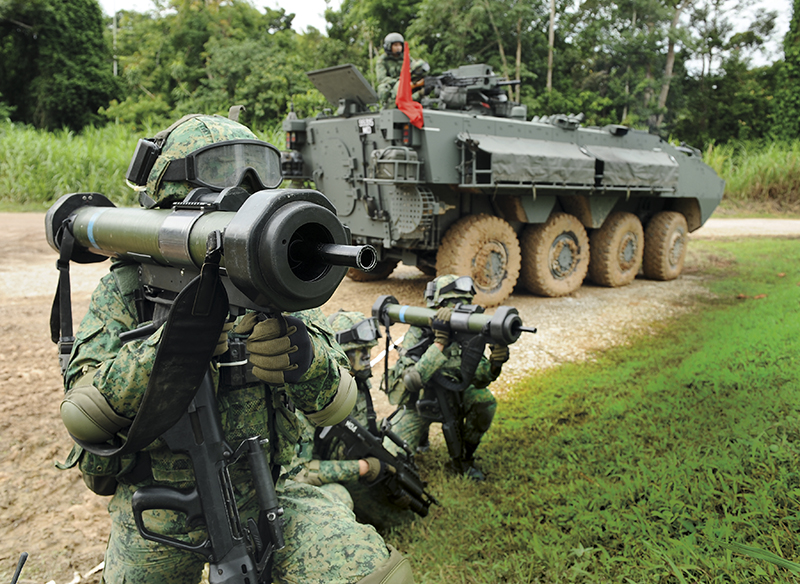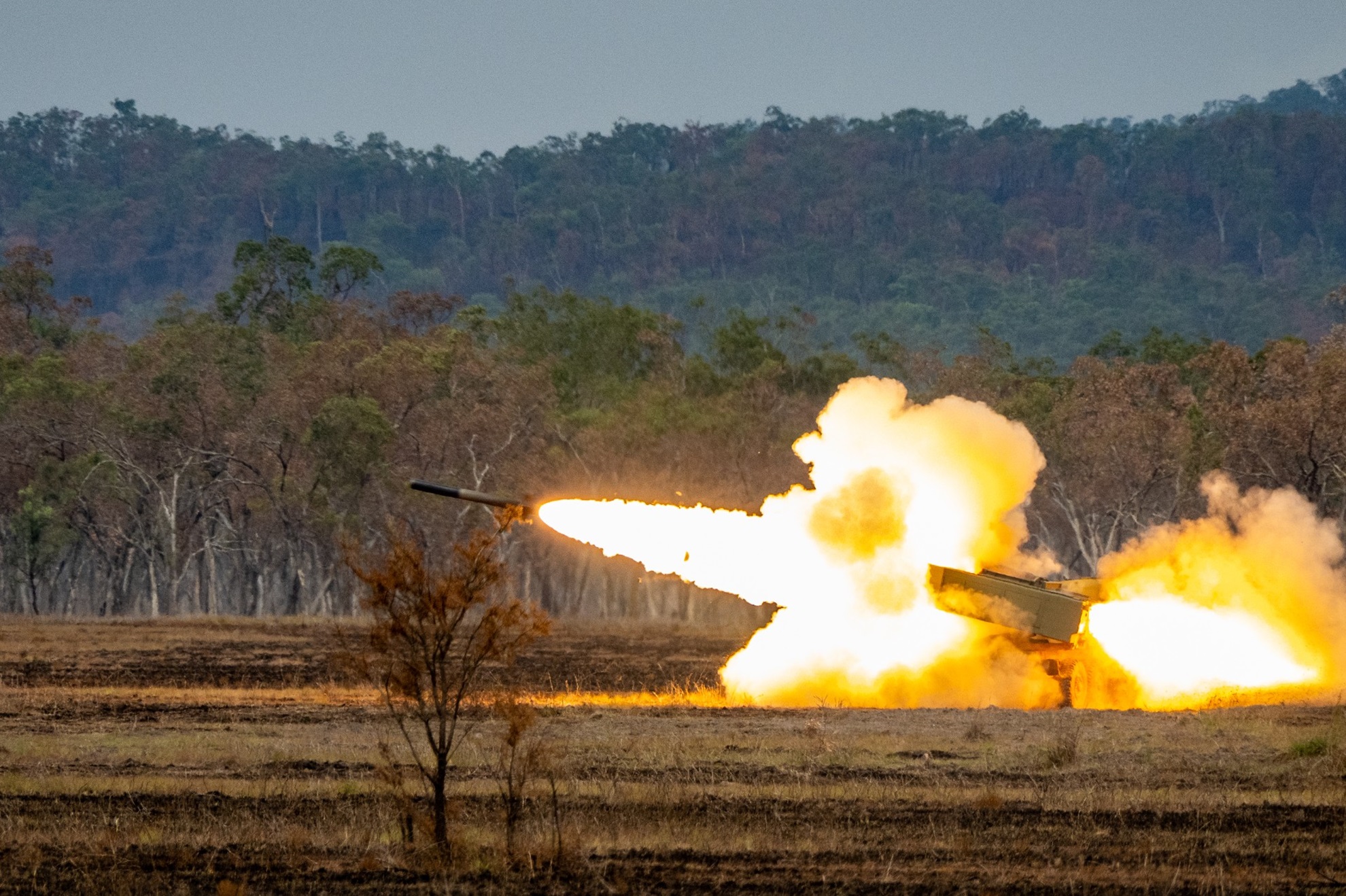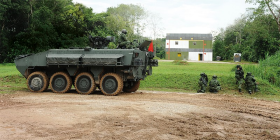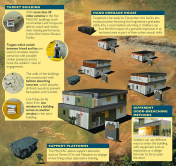OPS & TRAINING
NEW URBAN OPS LIVE FIRING FACILITY FOR EFFECTIVE TRAINING
14 Oct 2014

Live firing, action, explosions. Sounds like a scene from a Michael Bay movie? Nope. This is the kind of realistic training that the Murai Urban Live Firing Facility (MULFAC) has to offer to our soldiers.
Scouts have confirmed the enemy's location in a building within the Lim Chu Kang area. Soldiers swiftly pack into Terrex Infantry Carrier Vehicles (ICVs) and head towards the enemy's location.
About 500m away from their target, the troops set up the Close Firebase (CFB) and commence firing the General Purpose Machine Gun (GPMG) with the Terrex ICV's Remote Controlled Weapon System (RCWS) to support troops' movement towards their objective.
From behind the enemy's location, their reinforcements have appeared. To support the assault, Terrex ICVs and snipers form up at the Far Firebase (FFB) to take the enemy reinforcements down.
Back at the target building, the Close Cover Group takes over. While troops are still firing the GMPG from the CFB, another Terrex ICV pulls up nearer to the enemy building. Troops unload, armed with the Matador, a disposable anti-armour weapon system, and begin to fire, taking down enemy reinforcements on wheels. Once the assaulting troops are confident that they have the upper hand, two other Terrex ICVs arrive at the building to unload soldiers and then speed off.
The soldiers use explosives to get past the doors, proceed to storm the building and overcome the enemy forces.
Bigger facility, better training
This is a typical motorised infantry manoeuvre, which soldiers can now execute while training with live munitions at the MULFAC.
Comprising three double-storey and two single-storey buildings, two firebases (a close and a far firebase), and an After Action Review facility, the MULFAC can train up to company level or about 100 soldiers at any one time. Other urban operations live-firing facilities like the Multi-Mission Range Complex (MMRC) can train up to a section of soldiers or seven men at any one run.
The MULFAC began operations last October and was launched officially on 14 Aug by Minister for Defence Dr Ng Eng Hen.
"Mounting our Terrex vehicles, coming out of it, blowing up doors, getting access It gives them the realism," said Dr Ng. "In short, we now have a live-firing facility that our NSmen (Operationally Ready National Servicemen) and our soldiers can train in urban built-up areas."
Big guns and cars
With the MULFAC, support elements such as snipers, section anti-tank guns and Terrex ICVs can be brought into live-firing training sessions.
"Prior to the attack, the troops get to hear the sounds and impact of the big guns and they know that these support platforms will cover their advance into the building. This helps to boost their confidence," said Lieutenant (LTA) Laurent Huang.
The Platoon Commander from Headquarters (HQ) Guards added that being able to use explosives to blow up doors allows them to experiment with different door-breaching methods, especially for locked or booby-trapped doors, instead of the conventional pull, push or kick methods.
"We want the troops to be confident in using explosives and not be shocked at the blast. Using grenades and explosives should be second nature to them," explained the 24-year-old.
Other advantages of the training facility include firing at the building exterior, being able to engage in Close Quarter Battle (CQB), and firing from one building window to another.
To shoot or not to shoot?
During battle, soldiers must always be alert and observant. To that end, electronic targets which can switch between friend and foe are used during CQB training scenarios. This hones soldiers' ability to discern between enemies and civilians, and trains them to apply their rules of engagement - to shoot or not, and to kill or to simply injure.
"Once you enter the building, you don't know what's going to happen - whether it is a civilian or a foe, to fire at the right part of his body and at the right target," said Corporal First Class Junaidi Bin Lasa, a trooper from HQ Guards.
"It's good training, and keeps us on high alert."
"I trust my buddy with my life"
While these instinctive skills are already drilled into the soldiers when they go through CQB training at other facilities, the use of live rounds means that trust is of the utmost importance.
Lieutenant Colonel (LTC) Jackson Wu, Head Training Development and Doctrine from HQ Infantry/9th Division, said bluntly: "If the troops are not competent or there isn t enough trust developed during practice, rounds can go anywhere."
This is why soldiers must go through numerous training sessions at both the Murai Urban Training Facility and the MMRC first to build a certain level of competency, confidence and understanding among them.
At the MMRC, they practise CQB with live rounds at group and section levels. These sessions help soldiers hone their shooting capabilities and teamwork in urban operations before moving on to the MULFAC, where they will execute an integrated live mission manoeuvre with other platforms.
Absorbing damage
To ensure safety is never compromised, the buildings in the MULFAC were built using Ballistic Absorbing Concrete (BAC). Resembling typical concrete, BAC can absorb rounds to prevent backsplash (fragments flying out) and ricochet (rounds bouncing off the wall and flying in different directions).
As part of regular maintenance every two weeks, contractors will decide whether to replace the blocks after checking how deep the holes are and how far the rounds have entered.
The BAC can also absorb tracers, which are flammable. Used specially when fighting at night, the red spark in tracer rounds helps to indicate that a bullet is flying or the magazine is coming to an end. This is another advantage that the MULFAC provides, compared to other indoor live-firing facilities.
Urban warfare, tougher battle
With the modern battlefield often found in dense urban areas, it is important that the SAF is a capable force in urban operations.
Even with the aid of modern sensors, troops typically find urban warfare more challenging, compared to fighting in the jungle. Pillars and rooms, for instance, create blind spots that can lower their situational awareness. Buildings might also block radio communication.
Add up all these factors and it comes as no surprise that urban fighting usually incurs more casualties, said 1st Sergeant (1SG) Mohamad Nur-Hisham.
On the critical need for urban operations live-firing training, the Platoon Sergeant from HQ Guards explained: "When you fight in urban areas, you expect a higher casualty rate as you never know where the enemy might pop up from. You'll be also caught by surprise if a grenade is suddenly thrown your way. But we are trained and prepared for such situations."
Even bigger plans
As the SAF continues to progress with time, so will the MULFAC. In the works is a Hand Grenade House (HGH) where troops will be able to throw live grenades into a room before storming it. This is targeted to be ready by December and will be located within the MULFAC training area.
The first of its kind in the region, the HGH will allow soldiers to experience the effects of a fragmentary grenade going off in an enclosed environment. They will also be able to do this up to three times during active service, and one or two times as NSmen, compared to just once during Basic Military Training in the past.
"An explosion in an enclosed space is amplified many times. This gives soldiers a realistic feel of what it means to lob a grenade into a room and to fire accurately at targets amid the dust," explained LTC Wu.
For now, commanders and soldiers alike are glad to be training at this facility. Said LTA Huang: "The training at the MULFAC is so realistic, I trust that my soldiers can pull the trigger and do well when it comes down to the real thing."
"We envisage that the modern battlefield is going to be fought in a heavily dense urbanised area...so MULFAC comes in as a very useful facility to train our soldiers realistically for operations which they will be put into."
- Brigadier-General Chiang Hock Woon, Commander 9th Division and Chief Infantry Officer
Urban battle training zone
Soldiers will now get 50 to 60 percent more hands-on live-firing experience with the new Murai Urban Live Firing Facility (MULFAC), which can train up to company level (about 100 troops).
ALSO READ IN OPS & TRAINING

Exercise Wallaby 2025: To see better, shoot faster
31 Oct 2025
The SAF focuses on complex strike missions and multi-domain integration in Exercise Wallaby 2025, the 35th edition of its largest unilateral overseas exercise.

Ex Wallaby 25 – Greater Integration and Complexity
25 Oct 2025
The 35th edition of the SAF’s largest unilateral overseas exercise is an opportunity for expanded scale and deeper integration towards an effective, networked fighting force.

Ex Forging Sabre ramps up use of unmanned assets in integrated strike operations
12 Sep 2025
In this 10th edition of Exercise Forging Sabre, the SAF sharpened its cutting edge for the dynamic modern battlefield, with expanded integration between manned and unmanned platforms.





